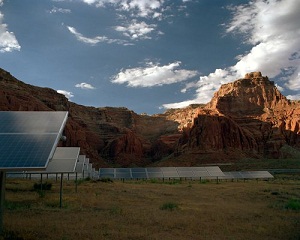DOE investigating community solar garden for capped uranium site
 The Department of Energy (DOE) is looking into building a 4-5 megawatt community solar garden at a former uranium mining site near Durango, Colo. Customer-members of the La Plata Electric Association, a cooperative utility, would be able to buy into the garden, which would be built in Ridges Basin (Bodo Canyon).
The Department of Energy (DOE) is looking into building a 4-5 megawatt community solar garden at a former uranium mining site near Durango, Colo. Customer-members of the La Plata Electric Association, a cooperative utility, would be able to buy into the garden, which would be built in Ridges Basin (Bodo Canyon).
“The Department of Energy owns the land in Ridges Basin where the old uranium tailings pile is located,” Mark Schwantes, LPEA manager of corporate services, said in a press release. The DOE has worked with other communities to develop similar sites. “We have been following their exploration of using their site here in Durango to do something similar,” he said.
The DOE recently completed an environmental assessment of the site and determined that the area was suitable for a solar array. LPEA is holding a Renewable Energy Generation meeting on August 11.
“The Renewable Generation Meeting on Aug. 11 will provide details regarding the DOE project. LPEA is hosting the meeting for the DOE,” said Susan Maxwell, an LPEA project specialist with its corporate services division.
At the meeting, representatives from the DOE will discuss the assessment and the next steps involved for developing a community solar garden.
The site proposed for the array is a 120-acre uranium tailing site buried under the ground and capped. The actual uranium waste cell is on 42 acres of the site. The solar array would cover a maximum of 42-acres, according to The Durango Herald.
The containment cell is covered with seven feet of layers that provide protection from radiation. The materials are capped with rock and soil, with another layer of rock to prevent vegetation from growing into the cap. Other layers include a radon membrane, a clay mat, and a sand-filter drain, the newspaper reported.
“We are in support of such a community solar garden,” LPEA CEO Greg Munro said the release. “We are not, however, necessarily interested in building the project ourselves, but will work closely with the solar developer selected to see if it can be a win-win for everyone.”
Unlike investor-owned utilities in Colorado, like Xcel Energy, community-owned utilities like LPEA aren’t required to source 30 percent of their generation from renewable resources. However, the co-op already has renewable generation in its portfolio including hydro power and some solar.
“LPEA currently has 1,285 kW of solar capacity installed in our service territory with over 270 net metered accounts,” Maxwell said.
Image courtesy of NREL.



